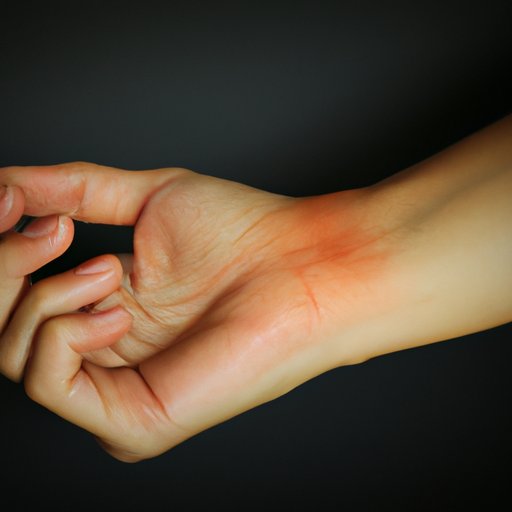
Introduction
De Quervain’s Tenosynovitis is a painful condition that affects the wrists and hands, causing inflammation and discomfort. This condition is often caused by repetitive motions, such as typing or using a computer mouse for extended periods. In this article, we will explore various treatment options for managing and reducing the symptoms of De Quervain’s Tenosynovitis.
Home remedies for De Quervain’s Tenosynovitis: A complete guide
One popular way to manage De Quervain’s Tenosynovitis is by practicing home remedies. These treatments can improve pain, inflammation, and aid in recovery. The following are some of the efficient home remedies for treating De Quervain’s Tenosynovitis:
Ice packs and rest
Icing the affected area and resting the wrist can ease swelling and reduce pain. Applying an ice pack for 15 to 20 minutes several times a day can provide much-needed relief. Additionally, avoiding repetitive motions and activities that strain the wrist is also crucial to giving the tendons time to heal.
Hand exercises and their role in recovery
Hand exercises can help reduce inflammation and enhance mobility, ultimately speeding up the healing process. One such exercise is making a fist with your thumb tucked under your fingers, followed by slowly straightening your wrist and fingers. Repeat this ten times, three times a day.
Dietary changes
Avoiding inflammatory foods like sugar and processed foods and increasing the intake of anti-inflammatory food like fresh fruits and vegetables and healthy oils like olive oil can assist in reducing pain and swelling caused by De Quervain’s Tenosynovitis.
Managing pain at home
Over-the-counter pain relievers like ibuprofen can provide relief from pain and inflammation. However, always consult with your doctor before taking any medication, as they might cause side effects or interact with other medications you may be taking.
Surgical vs. non-surgical treatments for De Quervain’s Tenosynovitis: What to expect?
If home remedies and other non-surgical treatments are not effective, your doctor will likely recommend surgical treatment. However, before going under the knife, patients can try other non-surgical treatment alternatives.
Non-surgical treatments
Non-surgical treatments for De Quervain’s Tenosynovitis include physical therapy, wearing a wrist splint, and taking medication such as corticosteroid injections or other pain relievers. Physical therapy entails working with a therapist to enhance hand strength, mobility and flexibility. Wrist splints decrease strain on the tendons and provide support when the wrist is in use. Your doctor might recommend medication like corticosteroid injections to alleviate pain and inflammation.
It is essential to note that these treatments may take some time before showing substantial results. Some people might require several weeks or months before they feel any improvement. Besides, these treatments may not work for everyone, and surgery could be the only solution eventually.
Surgical treatment
Surgical intervention involves cutting open the protective sheath that surrounds the wrist tendon, ultimately relieving pressure on the swollen tendons. Patients may have to wear a cast or splint around the wrist for several weeks following the surgical procedure to support and protect the wrist.
It is vital to remember that surgery has its risks and is always a last resort after all other treatments have failed.
Physical therapy for De Quervain’s Tenosynovitis: An effective solution
Physical therapy can be an effective solution to help manage and reduce symptoms caused by De Quervain’s Tenosynovitis. Physical therapists use a variety of techniques to improve hand strength, mobility, and flexibility.
Exercises that help alleviate the symptoms of De Quervain’s Tenosynovitis include wrist stretching, finger and thumb exercises, and resistance training. Physical therapists may also use massage and other stretching techniques to help reduce inflammation and improve range of motion.
The role of medications in treating De Quervain’s Tenosynovitis
Medications such as pain relievers and anti-inflammatory drugs can provide temporary relief from symptoms. However, as mentioned earlier, always consult with your healthcare provider before taking any medication, as they may have side effects or interact negatively with other medications you may be taking.
Corticosteroid injections are another potential treatment option. They can be most significant in treating pain and inflammation, but the effects might not be long-lasting, and there can be associated risks, including infection and tendon rupture.
Preventing De Quervain’s Tenosynovitis: A guide for those at risk
Prevention is always key, and with the following tips, one can reduce their chances of developing De Quervain’s Tenosynovitis:
Proper posture
Sitting with your back straight, feet flat on the floor, and shoulders relaxed can help keep wrist and hand muscles aligned, reducing the risk of strain.
Taking frequent breaks
Taking breaks throughout the day and avoiding repetitive movements can help reduce strain on the wrist and hand muscles.
Hand-strengthening exercises
Performing regular hand-strengthening exercises can enhance muscle support and mobility, thus reducing the risk of De Quervain’s Tenosynovitis.
Conclusion
In summary, De Quervain’s Tenosynovitis is a painful and potentially limiting condition that affects the wrist and hands. While several non-surgical treatments are available, surgery can also be a viable option if other treatments fail. Physical therapy, dietary improvement, hand-strengthening exercises, and medication may assist in reducing symptoms. Preventive methods, including proper posture and taking regular breaks, can also reduce the risk of developing De Quervain’s Tenosynovitis.
Resources for further reading
If you are interested in learning more about De Quervain’s Tenosynovitis, the following resources will be of use to you:
- De Quervain’s Tenosynovitis on the American Society for Surgery of the Hand website.
- Physical therapy treatments for De Quervain’s Tenosynovitis on Healthline.
- Preventing De Quervain’s Tenosynovitis on the Mayo Clinic website.





